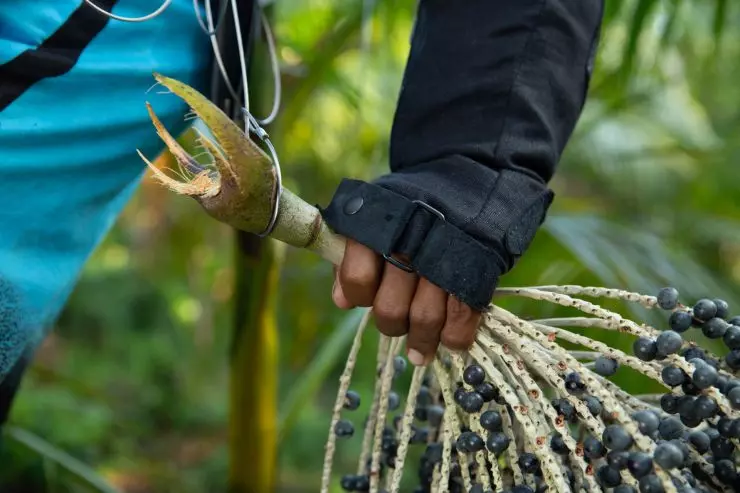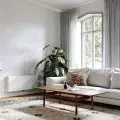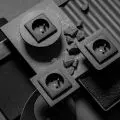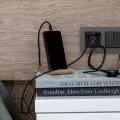interview fromA&B issue 02/2022
Dorota Kabała talks about physical activity, designing for the sports industry, responsibility in business and creativity, as well as a recent project in the Amazon forest.
Dorota KABAŁA - designer. She runs the studio We design for physical culture(www.we-design.studio), winner of the award of the Ministry of Culture, National Heritage and Sports in the Design 2021 category. She specializes in the sports and recreation industry, and in particular - in sustainable development. She also passes on her knowledge to entrepreneurs, in the PARP projects "Design for Entrepreneurs" or Universal Design, and as a lecturer at the School of Form of SWPS University.
Dominika Drozdowska: You primarily design equipment and accessories for the sports industry. How did it happen that you avoided inventing new chairs, sofas and tables?
Dorota Kabala: I have the impression that the image of a designer has just stopped at the level of designing elements for interiors, while many creators now also design other products and solutions. I don't know what this is due to, perhaps the history of architecture and its connection with furniture design, the way it is told in the media, and the widely understood luxury and prestige. Such perceptions of designers are slipping away from reality. In my case, the answer will be easy - I just don't like sitting [laughs]. Nor do I think that the issues that sofas, armchairs and chairs solve are the most pressing at the moment. Especially since this topic has already been addressed so many times. I think designers have the power and creative energy to use for issues other than purely aesthetic. Each of us has our own energy, skills and competence that we can channel in such a direction to push this world in the right direction. I try to pass this on to my students at School of Form. And sports came from my values, beliefs and life stories - I have a career as a member of the national team in synchronized swimming, and I still actively participate in several sports. From my own experience, I know how many benefits physical activity can bring to a person's life. With this in mind, I decided almost a decade ago that I wanted to combine it with design. For me, creating does not end with the implementation of a product. It is important that this product generates some further value and that something more comes out of it.
AEROSIZE Vest ONE
Left: photo: TOPO Visuals Adam Brandys; Right: photo: courtesy of AEROSIZE
Dominica:Speaking of that "more" and the common denominator of your designs - I found one feature: safety. It can be found in KIT dos Peconheiros, the AEROSIZE avalanche vest (Vest ONE) and accessories for the Nobile Kiteboarding brand.
Dorota: The safety aspect comes from the nature of designing for physical activity - for the body in motion in general. It is indeed the case that in the design of sports equipment, safety will come first, followed by ergonomics and comfort, and only at the end by aesthetics. Although aesthetics are very important, as they carry different content, sell and are responsible for brand communication, they are ultimately subordinated to safety and comfort. For example, when designing an avalanche vest, we won't use even the most interesting material with a great structure in it if it doesn't meet the standards or if snow settles on it making it difficult to open. Indeed, we have a lot of projects in the studio related to safety directly, but sometimes it is also invisible at first glance. When designing Maria Zimpel's contemporary dance costumes and objects, no one will say at the first moment that safety is the key, but it is indeed an overriding, very important feature. I am committed to designing products whose effect of use is positive. Coming back to the AEROSIZE avalanche vest - it is based on a hybrid air-pumping system patented in Poland. It was designed for, among other things, skiers and snowboarders, skitouring and snowmobile enthusiasts - off-piste enthusiasts. It is currently being tested and used by Austrian emergency services. It serves both the rescuers and, indirectly, the people they rescue.
{Image@url=https://cdn.architekturaibiznes.pl/upload/galerie/76703/images/original/7688ee6a8cc0d269fcdc420b1d1620d3.jpg,alt=Kampnagel Hamburg Space Gives Place by Maria Zimpel,title=Kampnagel Hamburg Space Gives Place by Maria Zimpel}
Kampnagel Hamburg Space Gives Place by Maria Zimpel
photo: Vera Drebusch
Dominika:All of your designs respond to a variety of needs.
Dorota: There are different approaches in design. Enough inquiries and subjects come to me and my studio that diagnose problems that I don't feel the need to generate designs entirely from within myself, as some designers do. Although sometimes these are not even queries, but rather interesting data related to phenomena against which we take further action. This was the case, for example, with the KIT dos Peconheiros project we are currently working on, which came from interesting research results about the target group. In my opinion, there are enough issues to solve that we have our hands full.
Dominica:Tell us, please, more about the KIT dos Peconheiros project.
Dorota:Peconheiros stands for a professional group - Brazilian acai berry pickers, and kit means kit. So we are working on a kit of accessories for acai berry pickers. The name, although it may cause problems outside Brazil, locally it is understandable and easy to remember. It's a long-term project in collaboration with Monika Brauntsch, who runs the company Kafti, and an international team made up largely of acai pickers from the state of Pará in Brazil. The project had already begun four years ago, just with the research that came our way. This was the first sociological research conducted among this professional group. Acai berries are used worldwide in the cosmetic and food industries, and supplements are also produced from them. They grow on the tops of palms up to a dozen meters high in the natural forests of the Amazon. Due to the fact that we are not talking about plantations here but natural forests, most of the harvesting is done by hand. If I remember correctly, more or less 90 percent of the berries come just from Brazil. Going back to the surveys that came to us at the time - as many as 89 percent of peconheiros admitted that they had suffered some sort of injury during harvesting, some of these injuries requiring hospitalization, many of them preventing work for several weeks. This rather high statistic was also quite a motivation for the development of the project. Next was an interesting and complicated process of building a team, acquiring partners and a target group for cooperation. Today we are at the stage where the first elements have been implemented, and more products are in development. The next big challenge is to sell the kit.



KIT dos Peconheiros is a kit for arboriculture and working at heights
photo: Chico Kfouri
Dominica:What is the response at this stage of the project?
Dorota: The equipment is being tested on a long-term basis, and since the first tests it is already past the second or third season of use. Of course, something had a right to break down or wear out in these models, but we are in constant contact with our testers and we know that this equipment has not hit the corner, but is in use. Which is an additional indicator that it works.
Dominica:What is included in the KIT dos Peconheiros?
Dorota: The kit includes forearm protectors, a belt with a knife sheath and a lasso. Both the protectors and the belt come in several sizes. Acai berries grow in bunches of several kilograms, so the lasso gives you the ability to bring the bunch to the ground. You can hang them in your preferred way, you can hold them in your hand, or clip them to your belt. Since each gatherer has his own ways and tricks he uses during harvesting, our kit is modular and can be customized to fit his needs. Peconheiros participate in the design process, so these solutions are jointly developed ideas, with the whole team working on the result. We also rely on distributed local knowledge. This is the role of a designer that I like best - without pointing fingers at what needs to be done, like some omniscient god. For me, being a designer means collaborating with the user, observing and catching information. It's being someone who puts together something that already really exists, only sometimes it doesn't have a physical form yet.



KIT dos Peconheiros
Photo credit: Chico Kfouri
Dominica:It's like connecting the dots. In the KIT dos Peconheiros project, in addition to working with local users, you also tried to create an environmentally friendly product.
Dorota: The aspect of design focused on the fact that humans are part of the ecosystem has been important to me since I got into design. Although I think it has always been important to me. I have such a memory still from the beginning of elementary school. We went with the class to the Old Zoo in Poznan, the hippopotamus lived there in a very small room, in my opinion it was difficult for him to turn around in it. In my childish mind I assumed it was because there was not enough money for a bigger space. So I founded the "association" Friends of Whales, so as not to be limited to hippos, and began producing lesson plan bookmarks, club member cards and other props painted with a marker on cardboard. Such bricks could be bought for any amount. However, at some point an adult made me realize that if I collected money, I had to pay tax. This scared me a lot and I didn't know what to do. I don't remember how it ended, I guess I gave the money I raised to the donors, and the whales and hippos had to fend for themselves, or wait until I understood the tax and accounting issues. Nowadays I support organizations dedicated to the conservation of various species and ecosystems. This is one of my memories, which quite strongly shows that nature and contact with it and being active have always been important to me. My first team project after studying in Poznan and Barcelona was the "re.product" exhibition, based on the 3R principle (reuse, reduce, recycle). It's important to me that the theme of ecology and sustainability continues, both in my projects and in public discussion. Although, of course, these issues are much more popular now than they were then, it's much easier to do bolder projects, with an eye on nature and man as part of the ecosystem, rather than a perpetrator out to save the world he previously destroyed. I think it is important for us to understand that we are part of the ecosystem. Today we have different technological and material possibilities than in 2009, when "re.product" was created, but the legal and business context has also changed, which favors the implementation of various projects. As a designer, I have a completely different position today than I did a decade ago. One listens differently to someone who has experience in the industry than to a fresh graduate. Although I think we should listen to what young designers and young people in general have to say. They have just as much power and knowledge, just differently shaped than mine and designers of my generation and older.



KIT dos Peconheiros
photo: Chico Kfouri
Dominica:Currently, a lot of responsibility for climate change is being placed on the ordinary user, while a lot more can be done by business and the state.
Dorota: This is a very complex issue. Certainly the responsibility of business is much greater than that of the individual user, because the scale of action is different and has a much greater impact. However, I think that as individuals we are not exempt from action and responsibility. Each of us is a consumer and a producer or user of various types of goods. After all, the world is made up of individuals, and there are also individuals behind business decisions. For some consumer behavior or buying habits, I see no justification. I am quite radical in this approach.
Dominika:On the other hand, consumers have an influence on what business does.
Dorota: Yes, this pressure exists. Although sometimes I feel that consumer awareness can be superficial. When someone asks in a store about a jacket made from recycled materials, it's not really about that. It's more about asking myself if I really need this jacket. If a company sees such shallow questions, indicative of remorse rather than deeper awareness, it may go greenwashing to please its audience. But of course, there are examples of companies that operate in a more responsible manner, such as the industry's change leader, Patagonia. Personally, I also appreciate Icebug, a company that doesn't just zero in on its operations, but does more to come out environmentally positive overall. I think that by the fact that the outdoor industry is close to nature, the environmental aspect is much more important than in other industries. Nevertheless, we need systemic solutions in this regard.



Nobile Kiteboarding is a safety system enclosure for kitesurfing,title=Nobile Kiteboarding is a safety system enclosure for kitesurfing
photo: Natalia Niedziela
Dominica:So we should, for example, reduce consumption globally?
Dorota: I think it is the legal solutions that are necessary. We are only human - we have weak wills or commitments and business goals to achieve. As humanity we are still evolving and in some respects we are just crawling. Take plastics - how long have they been around in the scale of humanity's existence? That time is very short indeed. The moment we are currently in is associated to me with the scene where a child has scattered his toys around the room and suddenly notices what a mess he has made, and now wonders how to clean it up and what to do better next time. The question is whether we have enough time and resources to clean up after ourselves and for ourselves. Although as humanity we don't have to survive at all. The planet will manage without us.
Dominica:That's not a very positive attitude... As a designer, you also look for the right materials and technologies. Have you come across any interesting materials recently?
Dorota: This is a very complex question, because it all depends on what the material is needed for. For me, natural materials are very interesting. Especially since some of them have made a career for historical and economic reasons, such as cotton. What if the basis for the garment industry was not cotton, but other fibers, such as flax, hemp? Perhaps the environmental and social costs could present a completely different balance sheet. A controversial material because of its origin is leather. While I am closest to vegan solutions, from a technical point of view, leather for some products is a great, durable material. Just a few days ago I was talking to a friend about the leather shoes she bought when she was a teenager and still has them today. It's been more than twenty years, and they are still in good condition. We also explored this topic from another angle in the studio: abstracting from the dream of a vegan world, and living in a world where meat is consumed and produced, can leather be treated as waste? According to CSO data and our conversations with tanneries and slaughterhouses in Poland, it turns out that yes. These are systemic questions that are posed rather vaguely and briefly in public discourse. It would seem that to avoid animal suffering, it is better to use plastic in a given product. And yet - living in a reality where animals are raised for food and leather is a waste product - it would be more reasonable to use leather, despite our discomfort with it. Wanting to be fair, we should first solve the issue of stopping meat eating, or industrial over-farming of animals, which in my opinion is the best solution, and only then give up leather as a material. There is also a lot of discussion around leather regarding the chemical waste generated during tanning and dyeing. Meanwhile, there are places in Poland where leather is vegetable tanned and dyed. If we plan to implement a material in a project, as a designer I always want to know where the material comes from and what its history is. Because just like with tanning and dyeing, these processes can be completely different in Asia and Poland. It's not just a matter of creating an eco-friendly, natural or properly sourced material - these are single aspects, and there are a mass of others that are interconnected and constitute a holistic systemic issue.
Nobile Kiteboarding IFS system kiteboarding pads and straps
Photo: courtesy of Nobile Kiteboarding
Dominic:It seems to me that as humans we are looking for the holy grail that will answer all our problems, and from what you are saying it seems that it all depends on the context.
Dorota: There are still many challenges in the world of materials, including textiles. How do you create an environmentally friendly material that is both water and wind resistant, without chemical impregnation or coatings that are impossible to separate from the fibers? This is the conundrum that various manufacturers, including Asian and Swiss companies, are currently trying to solve. Plastics, on the other hand, which have recently been strongly judged unsuitable for the environment, have great properties and great potential, especially if we can recycle them and don't use them once. Therefore, circular economy and closed-loop circulation of materials is also an interesting trend. Here, in turn, the question of raw materials arises, because, however, it is currently impossible to fully recycle a material without losing mass or quality, and a primary additive will be needed. This opens another section of questions, as in the case of plastics derived from plants - about plantations, large-scale cultivation, using chemicals.
Dominica:Concluding our conversation, I'd like to ask you about your experience of design situations, which you once said were essential in a designer's work.
Dorota: What I meant was that experiencing design and design problems is best tested on one's own skin. I've tested many sports before, so the experience that is most different from my everyday life is parkour training, which I took part in when we were designing just with this physical activity in mind. And, of course, climbing palm trees while working on KIT dos Peconheiros. This gave me a better understanding of mobility, body movement and the technique of ascending, descending and harvesting. I was able to climb to a height of three meters. For the higher ascent, I lacked the technical skills and I was a little afraid of the descent, or rather, of the climb. But it worked out!
Dominica:Thank you for the interview.












































